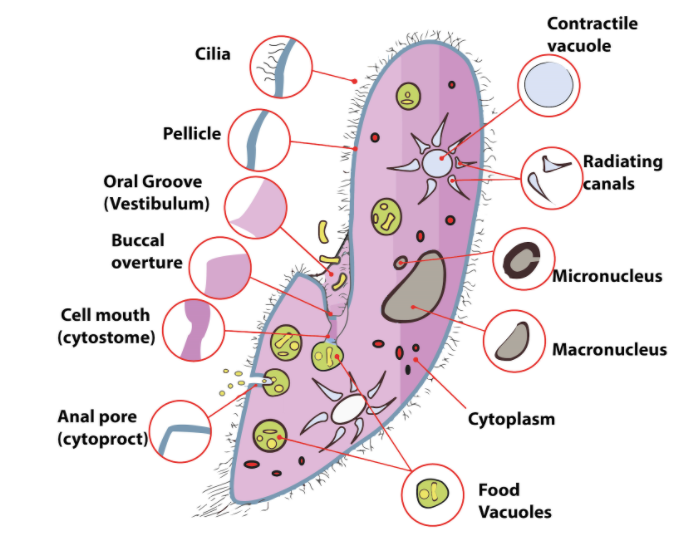
Draw a neat labelled diagram of Paramoecium
Answer
428.5k+ views
Hint: Paramecium is a genus of unicellular ciliated protozoa. They are characterized by the presence of thousands of cilia covering their body. They are found in freshwater, marine, and brackish water.
The coordinated movement of thousands of cilia propels paramecium. Paramecium can rotate around its axis and move in the reverse direction on encountering an obstacle.
The cell size varies from 50 µ to 300 µ. The cell is ovoid, slipper, or cigar-shaped.
Complete answer:

Parts of paramecium:
Pellicle: The cellular cytoplasm is enclosed in a pellicle. The pellicle is elastic and gives the cell its definite but changeable shape.
Cilia: They project from the depressions in the pellicle and cover the entire body surface. They are used for locomotion and taking nutrient-rich water inside the gullet.
Protoplasm: They are divided into outer ectoplasm and inner endoplasm, which is granular.
Paramecia contain at least two nuclei, micronuclei (one or more), and one macronucleus.
Micronuclei: They are diploid chromosomes and take part in the reproduction.
Macronuclei: They regulate all vital metabolic activities and growth. The macronucleus has multiple copies of the genome, i.e. polyploid.
Vacuoles: There are numerous food vacuoles present for digesting food
Contractile vacuoles: They are present and their number varies from species to species. They are required for osmoregulation and expel the additional absorbed water.
Oral groove: At the midpoint, there is an oral groove on the ventral side known as the vestibule. Food is drawn inside the cell due to the coordinated movement of cilia.
Cytostome: The oral groove opens in the mouth known as cytostome and to the gullet or pharynx.
Cytoproct: There is an anal pore present on the ventral surface in the posterior half of the cell known as cytoproct or cytopyge, which helps in egesting undigested food
Trichocysts: They are present and embedded in the ectoplasm. They are a defensive organ.
Endoplasmic granules: They reserve food. Some of the granules are secretory or excretory.
Note: They are mostly heterotrophic. They feed on bacteria, algae, yeast, and other microorganisms. They are holozoic. The food-laden water is drawn inside by the movement of cilia and it goes to the cytostome and to the gullet (cytopharynx).
The coordinated movement of thousands of cilia propels paramecium. Paramecium can rotate around its axis and move in the reverse direction on encountering an obstacle.
The cell size varies from 50 µ to 300 µ. The cell is ovoid, slipper, or cigar-shaped.
Complete answer:

Parts of paramecium:
Pellicle: The cellular cytoplasm is enclosed in a pellicle. The pellicle is elastic and gives the cell its definite but changeable shape.
Cilia: They project from the depressions in the pellicle and cover the entire body surface. They are used for locomotion and taking nutrient-rich water inside the gullet.
Protoplasm: They are divided into outer ectoplasm and inner endoplasm, which is granular.
Paramecia contain at least two nuclei, micronuclei (one or more), and one macronucleus.
Micronuclei: They are diploid chromosomes and take part in the reproduction.
Macronuclei: They regulate all vital metabolic activities and growth. The macronucleus has multiple copies of the genome, i.e. polyploid.
Vacuoles: There are numerous food vacuoles present for digesting food
Contractile vacuoles: They are present and their number varies from species to species. They are required for osmoregulation and expel the additional absorbed water.
Oral groove: At the midpoint, there is an oral groove on the ventral side known as the vestibule. Food is drawn inside the cell due to the coordinated movement of cilia.
Cytostome: The oral groove opens in the mouth known as cytostome and to the gullet or pharynx.
Cytoproct: There is an anal pore present on the ventral surface in the posterior half of the cell known as cytoproct or cytopyge, which helps in egesting undigested food
Trichocysts: They are present and embedded in the ectoplasm. They are a defensive organ.
Endoplasmic granules: They reserve food. Some of the granules are secretory or excretory.
Note: They are mostly heterotrophic. They feed on bacteria, algae, yeast, and other microorganisms. They are holozoic. The food-laden water is drawn inside by the movement of cilia and it goes to the cytostome and to the gullet (cytopharynx).
Recently Updated Pages
Master Class 11 Economics: Engaging Questions & Answers for Success

Master Class 11 Business Studies: Engaging Questions & Answers for Success

Master Class 11 Accountancy: Engaging Questions & Answers for Success

Master Class 11 English: Engaging Questions & Answers for Success

Master Class 11 Computer Science: Engaging Questions & Answers for Success

Master Class 11 Maths: Engaging Questions & Answers for Success

Trending doubts
State and prove Bernoullis theorem class 11 physics CBSE

What are Quantum numbers Explain the quantum number class 11 chemistry CBSE

Write the differences between monocot plants and dicot class 11 biology CBSE

Why is steel more elastic than rubber class 11 physics CBSE

Explain why a There is no atmosphere on the moon b class 11 physics CBSE

1 ton equals to A 100 kg B 1000 kg C 10 kg D 10000 class 11 physics CBSE




